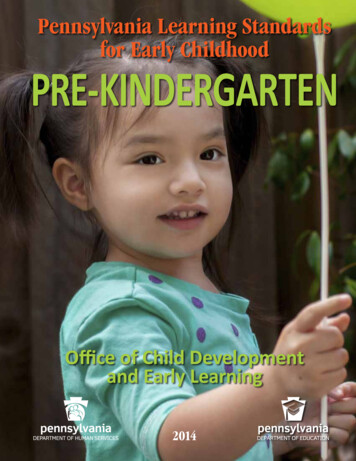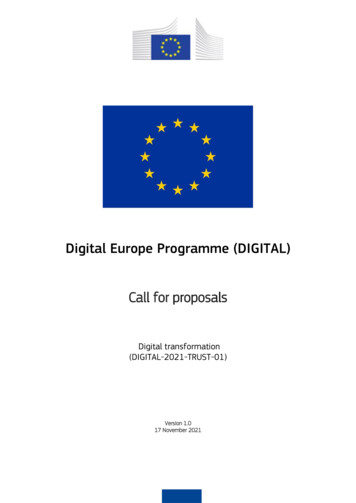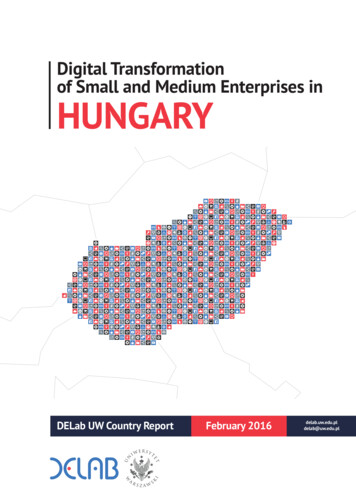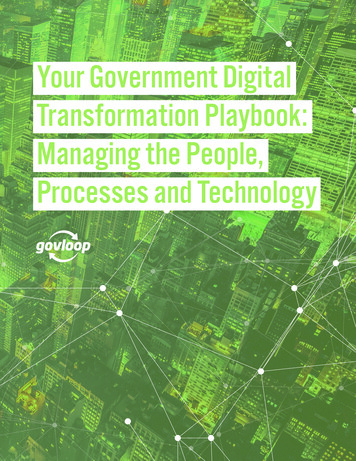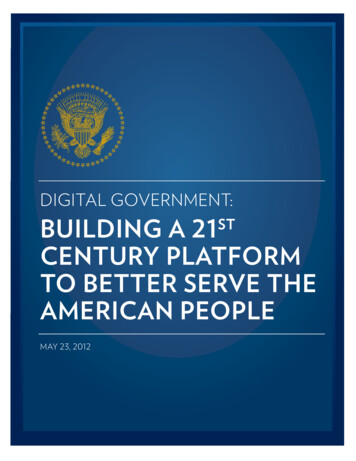
Transcription
DIGITAL GOVERNMENT:BUILDING A 21CENTURY PLATFORMTO BETTER SERVE THEAMERICAN PEOPLESTMAY 23, 2012
Table of ContentsIntroduction . . . . . . . . . . . . . . . . . . . . . . . . . . . . . . . . . .1Part A. Information-Centric . . . . . . . . . . . . . . . . . . . . . . . . . . . . 91. Make Open Data, Content, and Web APIs the New Default . . . . . . . . . . . . . . 102. Make Existing High-Value Data and Content Available through Web APIs . . . . . . . . 11Part B. Shared Platform . . . . . . . . . . . . . . . . . . . . . . . . . . . . . 133. Establish a Digital Services Innovation Center and Advisory Group . . . . . . . . . . 134. Establish Intra-Agency Governance to Improve Delivery of Digital Services . . . . . . . 155. Shift to an Enterprise-Wide Asset Management and Procurement Model . . . . . . . . 16Part C. Customer-Centric . . . . . . . . . . . . . . . . . . . . . . . . . . . . . 196. Deliver Better Digital Services Using Modern Tools and Technologies . . . . . . . . . . 197. Improve Priority Customer-Facing Services for Mobile Use . . . . . . . . . . . . . . 218. Measure Performance and Customer Satisfaction to Improve Service Delivery . . . . . . 22Part D. Security and Privacy . . . . . . . . . . . . . . . . . . . . . . . . . . . . 239. Promote the Safe and Secure Adoption of New Technologies . . . . . . . . . . . . . 2410. Evaluate and Streamline Security and Privacy Processes . . . . . . . . . . . . . . 24Conclusion . . . . . . . . . . . . . . . . . . . . . . . . . . . . . . . . . . . 27Appendix: Roadmap Milestones . . . . . . . . . . . . . . . . . . . . . . . . . . 29 i
Introduction“I want us to ask ourselves every day, how arewe using technology to make a real difference inpeople’s lives.” —President Barack ObamaMission drives agencies, and the need to deliver better services to customers at a lower cost—whether anagency is supporting the warfighter overseas, a teacherseeking classroom resources or a family figuring outhow to pay for college—is pushing every level of government to look for new solutions.The Speed of Digital InformationWhen a 5.9 earthquake hit near Richmond,Virginia on August 23rd, 2011, residentsin New York City read about the quake onTwitter feeds 30 seconds before they experienced the quake themselves.Today’s amazing mix of cloud computing, ever-smartermobile devices, and collaboration tools is changingthe consumer landscape1 and bleeding into government as both an opportunity and a challenge. Newexpectations require the Federal Government to be ready to deliver and receive digital information2 andservices3 anytime, anywhere and on any device. It must do so safely, securely, and with fewer resources.To build for the future, the Federal Government needs a Digital Strategy that embraces the opportunityto innovate more with less, and enables entrepreneurs to better leverage government data to improvethe quality of services to the American people.Early mobile adopters in government—like the early web adopters—are beginning to experiment in pursuit of innovation. Some have created products that leverage the unique capabilities of mobile devices.Others have launched programs and strategies and brought personal devices into the workplace. Absentcoordination, however, the work is being done in isolated, programmatic silos within agencies.Building for the future requires us to think beyond programmatic lines. To keep up with the pace ofchange in technology, we need to securely architect our systems for interoperability and opennessfrom conception. We need to have common standards and more rapidly share the lessons learned byearly adopters. We need to produce better content and data, and present it through multiple channelsin a program and device-agnostic4 way. We need to adopt a coordinated approach to ensure privacyand security in a digital age.1. Source for “The Speed of Digital Information”: /. Sources for“The Rapidly Changing Mobile Landscape”: http://hugin.info/1061/R/1561267/483187.pdf, http://www.idc.com/getdoc.jsp?containerId prUS23028711, ate-2012/Findings.aspx, one-shipment-numbers-passed-pc-in-q4-2010/.2. Digital information is information that the government provides digitally. Information, as defined in OMB CircularA-130, is any communication or representation of knowledge such as facts, data, or opinions in any medium or form,including textual, numerical, graphic, cartographic, narrative, or audiovisual forms. See http://www.whitehouse.gov/omb/circulars a130 a130trans4 for more information.3. Digital services include the delivery of digital information (i.e. data or content) and transactional services (e.g. onlineforms, benefits applications) across a variety of platforms, devices and delivery mechanisms (e.g. websites, mobileapplications, and social media).4. Device-agnostic means a service is developed to work regardless of the user’s device, e.g. a website that workswhether viewed on a desktop computer, laptop, smartphone, media tablet or e-reader. 1
D I G I TA L G OV E R N M E N T: B U I LD I N G A 2 1 S T C E N T U RY P L AT F O R MT O B E T T E R S E RV E T H E A M E R I C A N P E O P LEThese imperatives are not new, but many of thesolutions are. We can use modern tools and technologies to seize the digital opportunity and fundamentally change how the Federal Governmentserves both its internal and external customers—building a 21st century platform to better serve theAmerican People.The Rapidly Changing Mobile Landscape Mobile broadband subscriptions are expectedto grow from nearly 1 billion in 2011 to over 5billion globally in 2016. By 2015, more Americans will access theInternet via mobile devices than desktop PCs. As of March 2012, 46% of American adultswere smartphone owners – up from 35% inMay 2011. In 2011, global smartphone shipmentsexceeded personal computer shipments forthe first time in history.Strategy ObjectivesThe Digital Government Strategy sets out to accomplish three things: Enable the American people and an increasingly mobile workforce to access high-qualitydigital government information and services anywhere, anytime, on any device.Operationalizing an information-centric model, we can architect our systems for interoperabilityand openness, modernize our content publication model, and deliver better, device-agnosticdigital services at a lower cost. Ensure that as the government adjusts to this new digital world, we seize the opportunityto procure and manage devices, applications, and data in smart, secure and affordableways.Learning from the previous transition of moving information and services online, we nowhave an opportunity to break free from the inefficient, costly, and fragmented practices of thepast, build a sound governance structure for digital services, and do mobile “right” from thebeginning. Unlock the power of government data to spur innovation across our Nation and improvethe quality of services for the American people.We must enable the public, entrepreneurs, and our own government programs to better leverage the rich wealth of federal data to pour into applications and services by ensuring that datais open and machine-readable by default. 2
I ntroductionAbout this DocumentThe Digital Government Strategy complements several initiatives aimed at building a 21st century government that works better for the American people. These include Executive Order 13571 (StreamliningService Delivery and Improving Customer Service),5 Executive Order 13576 (Delivering an Efficient,Effective, and Accountable Government),6 the President’s Memorandum on Transparency and OpenGovernment,7 OMB Memorandum M-10-06 (Open Government Directive),8 the National Strategy forTrusted Identities in Cyberspace (NSTIC),9 and the 25-Point Implementation Plan to Reform FederalInformation Technology Management (IT Reform).10Through IT Reform, the Federal Government has made progress in foundational execution areas suchas adopting “light technologies” (e.g. cloud computing), shared services (e.g. commodity IT), modularapproaches for IT development and acquisition, and improved IT program management. The strategyleverages this progress while focusing on the next key priority area that requires government-wideaction: innovating with less to deliver better digital services. It specifically draws upon the overall approachto increase return on IT investments, reduce waste and duplication, and improve the effectiveness of ITsolutions defined in the Federal Shared Services Strategy.11The Digital Government Strategy incorporates a broad range of input from government practitioners,the public, and private-sector experts. Two cross-governmental working groups—the Mobility Strategyand Web Reform Task Forces—provided guidance and recommendations for building a digital government. These groups worked with the Office of Management and Budget (OMB) and General ServicesAdministration (GSA) to conduct current state research (e.g. the December 2011 State of the FederalWeb Report12) and explore solutions for the future of government digital services. Feedback was alsoincorporated from citizens and federal workers across the nation using online public dialogues, includingthe September 2011 National Dialogue on Improving Federal Websites and the January 2012 NationalDialogue on the Federal Mobility Strategy which produced a combined total of 570 ideas and nearly 2,000comments.135. andimproving-customer-ser6. ective-andaccountable-gov7. assets/memoranda 2010/m10-06.pdf8. http://www.whitehouse.gov/the press office/Transparency and Open Government9. http://www.whitehouse.gov/sites/default/files/rss viewer/NSTICstrategy 041511.pdf10. on-Plan-to-Reform-Federal%20IT.pdf11. http://www.cio.gov/documents/Shared Services Strategy.pdf12. The State of the Federal Web Report, released in December 2011, was created based on agency-providedinformation and can be found at 13. The National Dialogues are archived at http://web-reform-dialogue.ideascale.com/ (Improving Federal Websites) andhttp://mobility-strategy.ideascale.com/ (Federal Mobility Strategy). 3
D I G I TA L G OV E R N M E N T: B U I LD I N G A 2 1 S T C E N T U RY P L AT F O R MT O B E T T E R S E RV E T H E A M E R I C A N P E O P LEConceptual ModelBefore discussing how we will build a 21st century digital government, we must first establish a conceptual model that acknowledges the three “layers” of digital services (see Figure 1).The information layer contains digital information. It includes structured information (e.g., the mostcommon concept of “data”) such as census and employment data, plus unstructured information (e.g.,content), such as fact sheets, press releases, and compliance guidance.14The platform layer includes all the systemsand processes used to manage this information. Examples include systems for content management, processes such as webAPI (Application Programming Interface)15and application development, services thatsupport mission critical IT functions such ashuman resources or financial management,as well as the hardware used to access information (e.g. mobile devices).“Customers”AmericanPeopleGovt DigitalServices(Websites &Applications)The presentation layer defines the mannerin which information is organized and provided to customers. It represents the way thegovernment and private sector deliver government information (e.g., data or content)digitally, whether through websites,16 mobileapplications, or other modes of delivery.EmployeesPrivate SectorDigital Services(Websites &Applications)Systems, Processes,Management & Web APIsOpen Data & InformationLayerSecurity & PrivacyThese three layers separate information creation from information presentation—allowFigure 1: The Layers of Digital Servicesing us to create content and data once, andthen use it in different ways. In effect, this model represents a fundamental shift from the way ourgovernment provides digital services today.14. For the purposes of this document, the term “content” will refer to all unstructured information, while the term “data”will refer to all structured information unless otherwise noted.15. Web APIs are a system of machine-to-machine interaction over a network. Web APIs involve the transfer of data, butnot a user interface.16. A website is the hosted content on a domain, which has a unique homepage and global navigation, e.g., NASA.v isa domain, but www.nasa.gov and jpl.nasa.gov are both websites on that domain. 4
I ntroductionStrategy PrinciplesTo drive this transformation, the strategy is built upon four overarching principles: An “Information-Centric” approach—Moves us from managing “documents” to managingdiscrete pieces of open data and content17 which can be tagged, shared, secured, mashed upand presented in the way that is most useful for the consumer of that information. A “Shared Platform” approach—Helps us work together, both within and across agencies, toreduce costs, streamline development, apply consistent standards, and ensure consistency inhow we create and deliver information. A “Customer-Centric” approach—Influences how we create, manage, and present datathrough websites, mobile applications, raw data sets, and other modes of delivery, and allowscustomers to shape, share and consume information, whenever and however they want it. A platform of “Security and Privacy”—Ensures this innovation happens in a way that ensuresthe safe and secure delivery and use of digital services to protect information and privacy.Information-CentricThe Federal Government must fundamentally shift how it thinks about digital information. Ratherthan thinking primarily about the final presentation—publishing web pages, mobile applications orbrochures—an information-centric approach focuses on ensuring our data and content are accurate,available, and secure. We need to treat all content as data18—turning any unstructured content intostructured data—then ensure all structured data are associated with valid metadata.19 Providing thisinformation through web APIs helps us architect for interoperability and openness, and makes dataassets freely available for use within agencies, between agencies, in the private sector, or by citizens.This approach also supports device-agnostic security and privacy controls, as attributes can be applieddirectly to the data and monitored through metadata, enabling agencies to focus on securing the dataand not the device.17. Open data and content for the purposes of this document refers to digital information that is structured andexposed in a way that makes it accessible for meaningful use beyond its system of origin, be that internal to thegovernment or external to the public. This builds upon the definition of “openness” in OMB Memorandum M-10-06(Open Government Directive), which specifically addresses the release of information to the public: “Agencies shallrespect the presumption of openness by publishing information online To the extent practicable and subject tovalid restrictions, agencies should publish information online in an open format that can be retrieved, downloaded,indexed, and searched by commonly used web search applications. An open format is one that is platformindependent, machine readable, and made available to the public without restrictions that would impede the reuse of that information.” See rnment-directive for moreinformation.18. To treat content as data and turn unstructured content into structured data, web-based documents must be createdas pieces of structured information. For example, a fact sheet may be broken into the following component datapieces: the title, body text, images, and related links.19. Metadata are information used to describe certain attributes of a piece of digital information, such as page title,author, date updated, and other classifications. Consistent quality metadata tagging can improve search results andalso be used to structure content so that it can be more widely disseminated. 5
D I G I TA L G OV E R N M E N T: B U I LD I N G A 2 1 S T C E N T U RY P L AT F O R MT O B E T T E R S E RV E T H E A M E R I C A N P E O P LEIn production, the information-centric approach ensures all agencies follow the same “rules of the road”by using open standards. It also guides how we present information, from mobile applications to websites, and allows for increased automation at the presentation layer. If done right, the information-centricapproach will add reach and value to government services by helping to surface the best informationand making it widely available through a variety of useful formats.Shared PlatformTo make the most use of our resources and “innovate with less”, we need to share more effectively, bothwithin the government and with the public. We also need to share capacities to build the systems andprocesses that support our efforts, and be smart about creating new tools, applications, systems, websites and domains. Ultimately, a shared platform approach to developing and delivering digital servicesand managing data not only helps accelerate the adoption of new technologies, but also lowers costsand reduces duplication. To do so, we need to rapidly disseminate lessons learned from early adopters,leverage existing services and contracts, build for multiple use cases at once, use common standardsand architectures, participate in open source communities, leverage public crowdsourcing, and launchshared government-wide solutions and contract vehicles.20Customer-CentricFrom how we create information, to the systems we use to manage it, to how we organize and present it, we must focus on our customers’ needs. Putting the customer first means quality information isaccessible, current and accurate at any time whether the customer is in the battle field, the lab, or theclassroom. It means coordinating across agencies to ensure when citizens and employees interact withgovernment information and services, they can find what they need and complete transactions with alevel of efficiency that rivals their experiences when engaging with the private-sector.The customer-centric principle charges us to do several things: conduct research to understand thecustomer’s business, needs and desires; make content more broadly available and accessible and presentit through multiple channels in a program- and device-agnostic way; make content more accurate andunderstandable by maintaining plain language and content freshness standards; and offer easy pathsfor feedback to ensure we continually improve service delivery. The customer-centric principle holdstrue whether our customers are internal (e.g. the civilian and military federal workforce in both classifiedand unclassified environments) or external (e.g. individual citizens, businesses, research organizations,and state, local, and tribal governments).Security and PrivacyAs the Federal Government builds for the future, it must do so in a safe and secure, yet transparent andaccountable manner. Architecting for openness and adopting new technologies have the potential tomake devices and data vulnerable to malicious or accidental breaches of security and privacy. They also20. A shared solution is a service such as web hosting, application support, or a content management system, providedby a single agency or organization, but used by many. For example, a central hosting platform that allows multipleagencies to host their web content rather than procuring separate infrastructure for each new project. 6
I ntroductioncreate challenges in providing adequate notice of a user’s rights and options when providing personallyidentifiable information (PII).Moving forward, we must strike a balance between the very real need to protect sensitive governmentand citizen assets given the realities of a rapidly changing technology landscape. To support information sharing and collaboration, we must build in security, privacy, and data protection throughout theentire technology life cycle. To promote a common approach to security and privacy, we must streamlineassessment and authorization processes, and support the principle of “do once, use many times”. We mustalso adopt new solutions in areas such as continuous monitoring, identity, authentication, and credentialmanagement, and cryptography that support the shift from securing devices to securing the data itselfand ensure that data is only shared with authorized users. When appropriate, requirements and solutions should be collaboratively developed with industry to match Federal Government needs, usingthe power of innovation and economies of scale to deliver better-value security and privacy products. 7
Part A. Information-CentricThe rich wealth of information maintained by the Federal Government is a national asset with tremendous potential value to the public, entrepreneurs, and to our own government programs. Thisinformation takes many forms. It can be unstructured content (e.g. press releases, help documents,or how-to guides) or more structured data (e.g. product safety databases, census results, or airlineon-time records). Regardless of form, to harness its value to the fullest extent possible, we must adoptan information-centric approach to digital services by securely architecting for interoperability andopenness from the start.Traditionally, the government has architected systems(e.g. databases or applications) for specific uses at specificpoints in time. The tight coupling of presentation andinformation has made it difficult to extract the underlyinginformation and adapt to changing internal and externalneeds. This has necessarily resulted in a duplication ofefforts and the building of multiple systems to servedifferent audiences where a single would suffice. Forexample, most websites are typically built with webpagessized specifically for computer screens. To serve mobileaudiences, many agencies build an entirely new mobilesite to present the same content to federal employeesand the public.Decoupling Data and PresentationThe Centers for Disease Control andPrevention (CDC) is liberating webcontent by decoupling data and presentation. Using a “create once, publisheverywhere mindset” and an API-drivensyndication service, CDC’s content flowseasily into multiple channels and is available for public and private reuse. Withinits own channels, content is updatedonce, and then easily displayed on themain CDC.gov web site, the mobile site atm.cdc.gov, and in the various modules ofthe CDC mobile app.An information-centric approach decouples informationfrom its presentation. It means beginning with the dataIn 2011, CDC’s liberated content wasor content,21 describing that information clearly, and thensyndicated to 700 registered partners inexposing it to other computers in a machine-readableall 50 US states, the District of Columbiaformat—commonly known as providing web APIs. Inand 15 countries and accounted for andescribing the information, we need to ensure it hasadditional 1.2 million page views.sound taxonomy (making it searchable) and adequatemetadata (making it authoritative). Once the structureof the information is sound, various mechanisms can be built to present it to customers (e.g. websites,mobile applications, and internal tools) or raw data can be released directly to developers and entrepreneurs outside the organization. This approach to opening data and content means organizationscan consume the same web APIs to conduct their day-to-day business and operations as they do toprovide services to their customers.In addition, by embedding security and privacy controls into structured data and metadata, data ownerscan focus more effort on ensuring the safe and secure delivery of data to the end customer and fewerresources on securing the device that will receive the data. For example, security of an endpoint device21. Unstructured content like web-based fact sheets must be broken into their component data pieces (e.g. the title,body text, images, and related links) and treated as structured data. 9
D I G I TA L G OV E R N M E N T: B U I LD I N G A 2 1 S T C E N T U RY P L AT F O R MT O B E T T E R S E RV E T H E A M E R I C A N P E O P LEbecomes less of a risk management factor if data is protected and authorized users must authenticatetheir identities to gain access to it.The private sector has proven an information-centric model for delivering digital services securelyand efficiently. The time has come for the Federal Government to embrace this approach in stride.Recognizing that simply publishing snapshots of government information is not enough to make itopen, we need to improve the quality, accessibility, timeliness, and usability of our data and contentthrough well-defined standards that include the use of machine-readable formats such as web APIs andcommon metadata tagging schemas.1. Make Open Data, Content, and Web APIs the New DefaultTo lay the foundation for opening data and content efficiently, effectively and accessibly, OMB willwork with representatives from across government to develop and publish an open data, content, andweb API policy for the Federal Government. This policywill leverage central coordination and leadership toFueling the App Economydevelop guidelines, standards, and best practices forThe City of San Francisco releases its rawimproved interoperability. To establish a “new default,”public transportation data on train routes,the policy will require that newly developed IT systemsschedules, and to-the-minute locationare architected for openness and expose high-value22updates directly to the public through webdata and content as web APIs at a discrete and digestservices. This has enabled citizen develible level of granularity with metadata tags23. Under aopers to write over 10 different mobilepresumption of openness, agencies must evaluate theapplications to help the public navigate Saninformation contained within these systems for releaseFrancisco’s public transit systems—moreto other agencies and the public, publish it in a timelyservices than the city could provide if itfocused on presentation developmentmanner, make it easily accessible for external use asrather than opening the data publiclyapplicable, and post it at agency.gov/developer in athrough web services.machine-readable format.#1.11.2Owner(s)Milestone ActionsOMBIssue government-wide open data, content, and web APIpolicy and identify standards and best practices for improvedinteroperability.AgenciesEnsure all new IT systems follow the open data, content, andweb API policy and operationalize agency.gov/developerpages. [Within 6 months of release of open data policy—see milestone 1.1]Timeframe (months)13612 22. High-value information is information that can be used to increase agency accountability and responsiveness;improve public knowledge of the agency and its operations; further the core mission of the agency; create economicopportunity; or respond to need and demand as identified through public consultation.23. Industry-standard markup language (e.g. XBRL, XML) will be used to the extent practicable. 10
Part A . I nformation - C entric2. Make Existing High-Value Data and Content Available through Web APIsRecognizing that change will not happen overnight, we need to adopt an efficient and cost effectiveimplementation strategy that will not place an undue burden on agencies to transition all existingsystems and information upfront. While the open data and web API policy will apply to all new systemsand underlying data and content developed going forward, OMB will ask agencies to bring existinghigh-value systems and information into compliance over a period of time—a “look forward, look back”approach. To jump-start the transition, agencies will be required to: Identify at least two major customer-facing systems that contain high-value data and content; Expose this information through web APIs to the appropriate audiences; Apply metadata tags in compliance with the new federal guidelines; and Publish a plan to transition additional systems as practical.Given the scope, scale, and complexity of some of these systems, agencies will be asked to prioritizerelease of data and content so the most valuable information is made available first. In cases where thesystem supports a website, content must also be structured, published through web APIs and taggedappropriately. Agencies will be required to engage with their customers24 within three months to identify the highest priority systems to transition, and work internally across communications, content, andinfrastructure teams (e.g. program leads, digital strategists, web managers, Chief Information Officers(CIOs), Chief Financial Officers (CFOs), Chief Technology Officers (CTOs), Chief Acquisition Officers (CAOs),Chief Public Affairs Officers, Geographic Information Officers (GIOs), and data managers to select thefinal candidates. GSA will help agencies develop web APIs through the Digital Services InnovationCenter (see section 3). Additionally, Data.gov will be expanded to include a
age the rich wealth of federal data to pour into applications and services by ensuring that data is open and machine-readable by default The Rapidly Changing Mobile Landscape Mobile broadband subscriptions are expected . to grow from nearly 1 billion in 2011 to over 5 billion globally in 2016 By 2015, more Americans will access the





